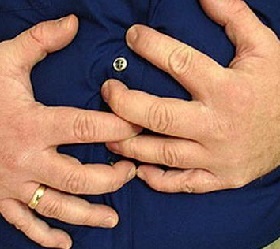With age, many people become cloudy and the capsule of the lens becomes denser. So shows itself a secondary cataract. This serious eye disease requires compulsory treatment.
In this article we will tell you what cataract is, how and why it arises, and how to cure it so that complications do not arise.
Content
- 1What is secondary cataract
- 2Causes
- 3Symptomatology
- 4Complications
- 5Methods of treatment and further prevention
- 6Video
- 7conclusions
What is secondary cataract
Secondary cataract is a complication after an operation to remove cataracts (a turbid lens).It can occur in ten to fifty percent of cases in people with a distant lens.
Cataract, which arose secondary, leads to a significant loss of vision.
The opacity of the lens may be the result of epithelial cells beginning to grow on the back wall of the capsule. However, such a problem is not a consequence of a surgical operation. It arises from the violation of the process of cell division of the capsule.
Secondary cataracts are divided into two types: primary opacities and secondary.
- The opacities that have arisen primarily are the result of surgical cataract treatment.They can appear immediately or after a while. Dimensions of opacities can be of different shapes and sizes. It is worth noting that in the presence of primary opacities vision does not deteriorate, so treatment in this case is not necessary.
- The turbidity that occurs again appears either immediately after the operation, that is, in the early stages, or because of incorrect cell reactions at later stages.Such opacifications can reduce the effectiveness of the operation.
Another distinguishing feature of cataract classification is:
- Nuclear cataract.It appears when the age-related changes in vision begin to flow incorrectly, while the lens core is involved. The satellite of nuclear cataract is myopia. The nucleus of the lens gradually changes its color from yellowish to brown.
- Subcapsular cataract.It can be front and back. In the first case, cataract develops under the capsule, and in the second - anterior to the posterior capsule. In the case of posterior cataracts, vision is significantly reduced. A person has residual vision, and he does not see well in bright light. The function of fixing the near object is violated.
- Bifurcated cataract.This species is rare. Bifurcated cataract is characterized by the appearance of a large number of deposits of different colors, which have an acicular shape.
- Cortical cataract. It is capable of capturing all parts of the lens (anterior, posterior, equatorial).
The rate of development of secondary cataracts depends on several reasons.First, it's age.The older the person, the worse the ability to regenerate (restore).Secondly, the intensity of the formation of the disease is significantly affected by the degree of manifestation of inflammatory processes. Thirdly, concomitant diseases play an important role in this case.
Causes
Primary cataract is natural and develops after forty years. It can occur because of eye injuries, poisoning with chemicals or biological substances, because of the harmful effects of various kinds of radiation.
A secondary cataract can occur for a variety of reasons.It can develop throughout the life of a person.Secondary cataract is a consequence:
- Autoimmune processes in the body;
- Myopia of high degree;
- Retinal detachment;
- Various inflammations in the choroid;
- Problems with metabolism (metabolism);
- Endocrine diseases;
- Incomplete resolution of lens masses, which appeared with trauma;
- Incomplete removal of lens parts during surgery.
Symptomatology
The first "bells" that will prompt the problem will appear in the fact that the items will be duplicated, the images will have a yellowish tinge, a ripple will appear before your eyes, when reading the letters will strongly contrast with the background.
At each stage of the development of the disease, the cataract manifests itself in different ways.
The early stage is characterized by the fact that vision can not decrease.It lasts an average of two to ten years.After that, those same symptoms begin to appear, and vision begins to decrease.
The pupil acquires a yellow or gray color.
The symptoms of cataracts vary depending on the zone of opacity of the lens. So, for example, the secondary cataract that has arisen on the periphery of the lens will affect the visual acuity.The closer to the center of the lens, the stronger the vision will fall. In this case myopia is manifested, vision becomes fuzzy, objects are doubled.
Complications
Secondary cataract, which was removed with a laser, practically does not give complications. But in very rare cases, they can arise.
Possible complications include:
- Brush retina swelling.Edema occurs when treatment of a secondary cataract is performed earlier than six months after the first operation. This problem arises from the large load on the retina. In the case of treatment after six months, the risk of developing retinal edema is minimal.
- Damage to the artificial lens.This complication arises from the doctor's mistakes when it can incorrectly calibrate the laser or poorly focus the laser beam on an artificial lens. As a result, dots appear on the lens, which affect the quality of vision.
- Chronic endophthalmitis.It develops only as a result of entering into the eye of bacteria by a doctor or by the person himself.
- Regmatogenic retinal detachment.Occurs when severe myopia. This complication is very rare.
- Displacement of the artificial lens.This problem often occurred during a re-surgical operation. But when using a laser for the treatment of secondary cataracts, the risk of complications is minimal.
Methods of treatment and further prevention
A few years ago, secondary cataracts were removed only surgically. But surgical intervention, although it is carried out quite simply, has several shortcomings:
- The risk of eye infection increases;
- Eye injury may occur;
- Probability of the formation of a hernia;
- Edema of the cornea after surgery.
Currently, secondary cataracts are treated with a laser. It allows you to carry out the procedure quickly and without pain, while permanently eliminating cataracts.
The advantages of laser treatment include:
- There is no need to take tests;
- The operation time is reduced to several minutes;
- There are practically no restrictions after the operation.
Laser treatment is based on the use of a powerful beam. He removes that part of the capsule of the lens, which was affected by cataracts. A film of pathogenic cells that was formed on an artificial lens is removed in a similar way.
One of the most effective ways to treat a secondary cataract is ultrasonic crushing of the ocular nucleus.This operation is recommended for people who have secondary cataracts still in an immature stage.
As for the treatment of secondary cataracts with medications, it can be said that this is ineffective.To date, there are about sixty medicines used to combat cataracts.These include eye drops based on potassium, magnesium, calcium and iodine salts. Additional components: vitamins, hormones and so on.
A good means of preventing the development of secondary cataracts are anti-catarrhal drugs. They are available in the form of eye drops.
The drug and its dose should be prescribed by an ophthalmologist.
Video
.List of vitamins for eyes to improve vision: article.
What is the retinal detachment and what are the signs of this disease read in this article.
Treatment of blepharitis in the home: http://eyesdocs.ru/zabolevaniya/blefarit/blefarit-vek-simptomy-diagnostika-lechenie-profilaktika.html
.conclusions
The reasons for the appearance of such a dangerous disease as secondary cataract is quite a lot. But it is always the result of an operation to remove cataracts. To anticipate or prevent a secondary cataract after the lens replacement is rather difficult, therefore the main advice that can be given is regular observation by the ophthalmologist of the operation field. This will help to detect the problem at an early stage and begin the necessary treatment.



